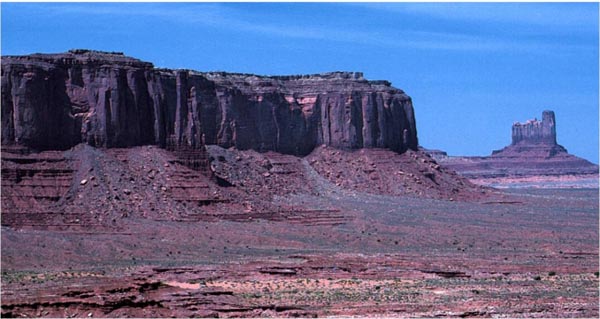Chapter 1. Deserts
Map Learning Exercises
Question 1 of 2
Deserts: Alluvial fans
Click on an alluvial fan or talus cone.
Consider this photograph of a desert landscape.
{"title":"selection","description":"","type":"correct","color":"#99cc00","code":"[{\"shape\":\"poly\",\"coords\":\"61,150,95,136,122,156,145,140,175,149,180,190,223,216,159,227,33,220,69,176\"},{\"shape\":\"poly\",\"coords\":\"315,194,273,196,291,211,258,218,198,182,228,184,198,166,201,154,193,136,230,142,269,154,288,166\"},{\"shape\":\"poly\",\"coords\":\"10,221,152,234,237,219,354,227,353,205,314,186,301,142,350,186,328,133,391,178,448,192,419,146,456,174,518,194,577,191,596,202,596,242,376,251,0,282\"}]"} {"title":"cliff","description":"This is the most resistant rock in the image. It is forming a cliff. Talus cones form from debris that has fallen from this rock.\n","type":"incorrect","color":"#993300","code":"[{\"shape\":\"poly\",\"coords\":\"1,46,87,41,188,65,287,70,364,67,417,82,425,150,319,140,298,157,187,131,204,159,98,142,1,151\"},{\"shape\":\"poly\",\"coords\":\"494,115,496,149,565,143,559,97\"}]"} {"title":"sedimentary","description":"This is rock, not loose debris. You can see the layers in this rock.\n","type":"incorrect","color":"#ffffff","code":"[{\"shape\":\"poly\",\"coords\":\"5,152,58,152,68,176,29,224,2,219\"},{\"shape\":\"poly\",\"coords\":\"181,150,191,138,195,171,257,221,230,222,180,186\"},{\"shape\":\"poly\",\"coords\":\"267,215,345,225,352,204,319,192,298,151,275,148,312,192\"},{\"shape\":\"poly\",\"coords\":\"368,145,425,148,443,187,393,171\"},{\"shape\":\"poly\",\"coords\":\"450,153,567,149,594,162,591,191,480,186,437,162\"}]"}Source: Raymond Siever.
Correct.
Please try again.
